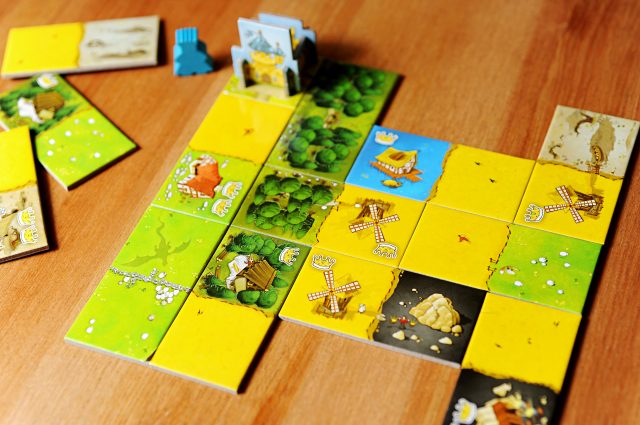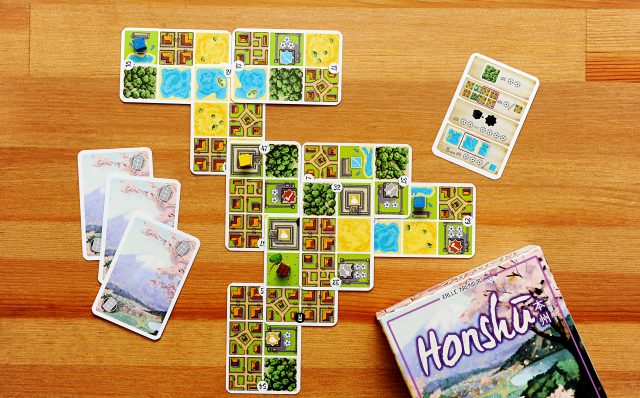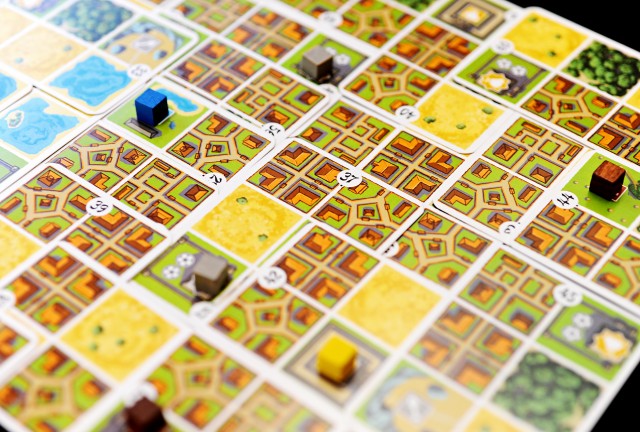Scholars in the history of science have a term called simultaneous invention. Sometimes, they say, conditions are such that an idea or discovery is “in the air” and accessible to many people at once. The mental soil is so fertile, as it were, that multiple (but separate) plants sprout separately and without any knowledge of each other. The invention of calculus by Newton and Leibnitz is a classic example, as is the “discovery” of oxygen by Scheele, Priestley, and Lavoisier.
Back at the start of the yearI got to play a little game called Honshu, by Kalle Malmioja, a new designer on the scene. It was a clever little game of bidding and city-building, and I liked it a lot. It was only available by import, though, so I pre-ordered a copy and waited for its arrival in February, 2017.
And waited, and waited…
In the meantime, Kingdomino, by the eminent Bruno Cathala was released. Cathala is the designer of Shadows Over Camelot and Five Tribes, and co-designer of 7 Wonders Duel (which I wrote about a couple of weeks ago). It was also a clever little game of bidding and city-building, and I liked it a lot. Clearly, so did many other people, because last week it was announced as one of the nominees for this year’s Spiel Des Jahres, Germany’s Board Game of the Year.
Coincidentally, last week finally saw the North American release of Honshu (by Renegade Games, publisher of Clank!), so I thought I’d take the opportunity to talk about both games, and speculate a bit on why one is getting so much more love than the other despite their similarities.
To me, these two games are a clear-cut example of simultaneous invention. The time was clearly ripe for a game which combined bidding with tile/card-laying. It is fascinating for me to see how two designers took the same idea and ran with it in different ways.
 In Kingdomino, players are local lords assembling fiefs out of domino-shaped tiles each consisting of two squares of terrain. Some squares have one or more crowns on them. Not all terrains are created equally; deserts are the most common but have the fewest crowns overall, for instance, whereas mountains are very rare but can have up to three crowns on them.
In Kingdomino, players are local lords assembling fiefs out of domino-shaped tiles each consisting of two squares of terrain. Some squares have one or more crowns on them. Not all terrains are created equally; deserts are the most common but have the fewest crowns overall, for instance, whereas mountains are very rare but can have up to three crowns on them.
Players are trying to assemble large contiguous blocs of forests, fields, swamps, etc. which contain as many crowns as possible. At the end of the game, you multiply the size of each bloc by how many crowns it has to get its value, and your final score is the sum of these values. Oh, and your kingdom(ino) must stay within a 5×5 square, so don’t get any funny ideas there buster.
The really tricky part is how you draft your tiles every round. Each tile in the game is numbered, from 1 to 48. The lower-numbered tiles tend to have more commonly-found terrain and fewer crowns, whereas the high-numbered ones are more likely to be crown-rich and rare. The better the tile you chose last round, the later in turn order you’ll go this round. And players always know which tiles are coming up one round ahead.
The game only lasts twelve rounds, so each round is an exquisite balance between choosing tiles that are good for you versus choosing tiles which are even better for someone else, and between taking great tiles which risk setting you back in turn order versus taking yecchy tiles because you really want first choice next round.
Kingdomino scales well with 2, 3, or 4, is easy to set up, teach, and put away, and only takes about 15 minutes per game.
Over in Honshu, the game also lasts for twelve rounds (numerologists and da Vinci Code investigators take note). Instead of tiles, players will be building their cities out of numbered Province Cards split into six squares of varying terrains–so, hexominoes. They are not constrained by any overall shape–however, each card played must overlap (or be overlapped by) a previous card to some extent. Each type of terrain scores differently at the end of the game (with deserts not worth anything at all except as a tie-breaker).
 Two of the terrain types are interrelated: production squares and factories. Production squares give players a cube of one of four colours when added to a city. These cubes can be delivered to similar-coloured factories for end-of-game points OR they may be used to increase your bid during the Bidding Phase.
Two of the terrain types are interrelated: production squares and factories. Production squares give players a cube of one of four colours when added to a city. These cubes can be delivered to similar-coloured factories for end-of-game points OR they may be used to increase your bid during the Bidding Phase.
Players begin the game with a hand of six Province Cards. In the Bidding Phase, each player plays a card from their hand which functions both as a bid for turn order (based on its numerical value, possible boosted by a production cube) AND as their contribution to the common pool from which cards will be drafted. Once turn order is established players choose from among the played cards to add to their cities.
This means that you have lots to think about when you bid, because a high-numbered card which places you earlier in turn order might also be a card which, if picked by someone else, boosts their score considerably. Or do you just play a card you hope no one else picks regardless of its number, just so you can add it to your own city?
 Every third round the cards in players’ hands are either passed around (a la 7 Wonders) or replenished entirely. At the end of twelve rounds scores are tallied and a winner is declared.
Every third round the cards in players’ hands are either passed around (a la 7 Wonders) or replenished entirely. At the end of twelve rounds scores are tallied and a winner is declared.
Honshu plays well with 3 to 5 players. There are some special two-player rules which I have not tried so I cannot vouch for them. The game also comes with optional Endgame Scoring Cards which can be used to spice things up.
Looking at Kingdomino and Honshu side-by-side it’s fair to say there are many similarities but the latter is definitely the more complex of the two–not better or worse necessarily, just more involved. There are more options at every stage of play, making it more prone to analysis paralysis. The overall experience is comparable but more brain-burny. It’s definitely not a gateway game.
Which is probably why Kingdomino was nominated for the Spiel des Jahres and not Honshu. SdJ nominees (the shortlist of three, anyway) tend towards accessible, gateway games; recent nominees have included games like Splendor, Machi Koro, and Codenames. Meanwhile, the nominees for Kennerspiel category (for more complex games) seem to go to games which are more ambitious or rich in theme, such as Terraforming Mars, Pandemic: Legacy, or Rococo. Kingdomino hits the sweet spot, whereas Honshu is too complex for the main prize and not immersive enough for the Kennerspiel.
Luckily, because both games are relatively cheap and quite portable you can have both if you want. But if you have to choose one, I would recommend Honshu if you’re looking for a weightier experience and Kingdomino if you’re looking for something you can bust out for filler or friends new to tabletop gaming.
Is Samurai Gardener the same as Honshu? They look pretty similar.
[…] its mate? My opinion is that Queendomino takes Kingdomino’s simplicity and elegance (which I wrote about back in June) and adds unnecessary layers of complication. Those who say (and there are those who […]